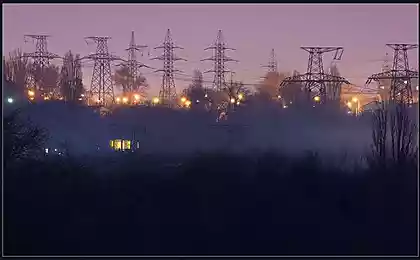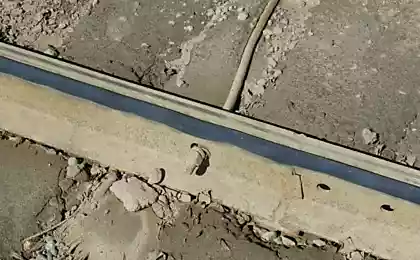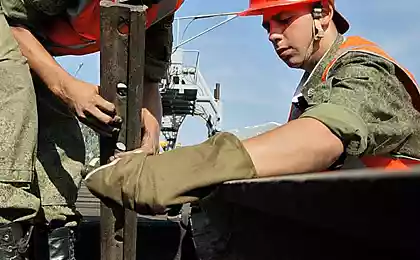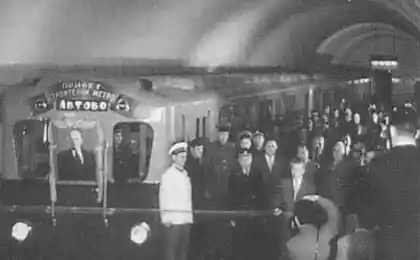2442
Most high-speed rail line
Yaponimya
The first solution to modernize its railways engaged in Japanese. It happened in the late 50s of last century. This was a necessary event in the run-up to the Tokyo Olympics in 1964. Because Japanese roads were archaic. Track width was only 1,067 mm, the paths were worn out, obsolete fleet of locomotives.
In record time, 5, 5 years, the Japanese built the broad-552-kilometer line "Shinkansen" connected Tokyo and Osaka. Here for the first time in the world of technology have been used jointless laying rails: they are soldered to the kilometer whip and in this form are delivered to the platform to the place of installation. The geometry of the junction of these lashes is that temperature changes do not lead to the formation of gaps between them.
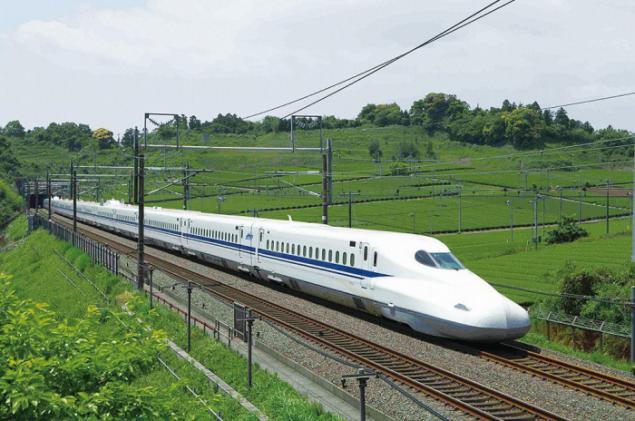
Naturally, there are no crossings on the line, which had to be built over hundreds of bridges and tunnels. On "Sinkansene" was used a fundamentally new type train that with the light hand of journalists was nicknamed "bullet-train". In the bullet train locomotive is missing: the engine is mounted on each axle, which can significantly increase the power.
In 1964, trains ran between Tokyo and Osaka with the speed of 210 km / h. Now train "Nozomi» N-700 flies 552 miles in 2 hours, 25 minutes, accelerating to 300 km / h. At the moment the "Shinkansen", linked together all the major cities of Japan - the most popular form of transport. In 50 years of operation of the train "Shinkansen" walking in the morning and evening with an interval of six minutes, transported nearly 7 billion passengers.
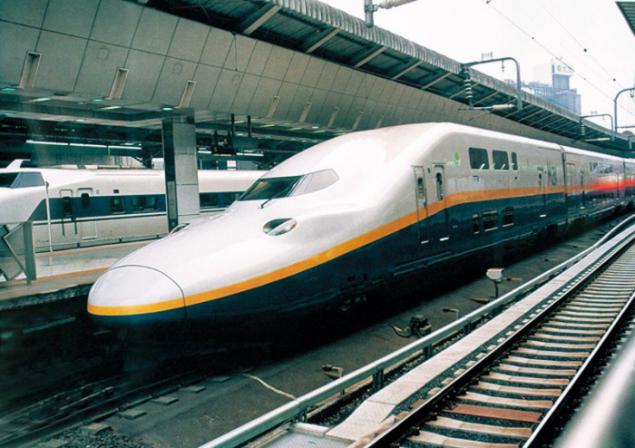
France
Europe responded to the Japanese railway breakthrough with a significant delay. This is partly explained by the fact that European designers in the 1950s-60s enthusiastically experimented with train hovercraft and maglev - the so-called maglev train.
The decision to create a high-speed line, similar to the Japanese, was made in France in the second half of the 1960s. National Railway Company of France took fifteen years to develop and launch the line Paris-Lyon, who was named the TGV (train a` grande vitesse - high speed train). Create route was though costly, but special problems the engineers did not cause. It was more difficult to construct the train itself. And here in the plans of designers unexpectedly intervened global economic conditions. The fact that the first stage was to be used as a locomotive engine gas turbine installation. In 1971 turbopoezd TGV-001 was successfully tested, showing excellent performance. It has a top speed 318 km / h, which is still the world record for trains without electric traction. As it happened in 1973, the energy crisis has forced the leadership to abandon the use of SNCF TGV rose sharply in the fuel. Has shifted to the use of less expensive electricity generated at the French nuclear power plants.
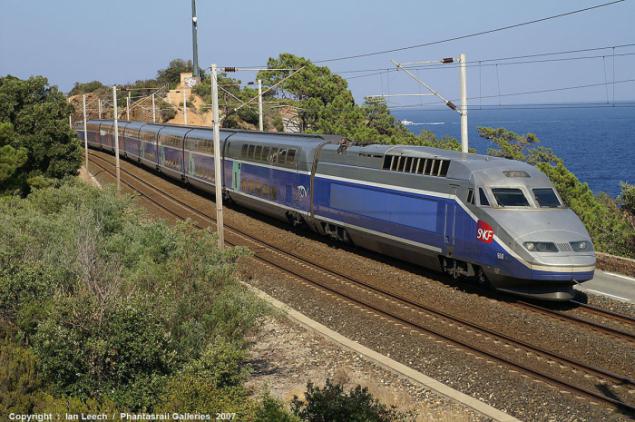
In the end, to the 80-th year and was ready to line Paris-Lyon. The locomotive and wagons manufactured by Alstom. September 27, 1981 the line was put into operation. The distance between the two French cities overcame train 2 hours, moving at a speed of 260 km / h. Now speed lines TGV, covered Europe, reaches 350 km / h. As for the average speed, it is 263, 3 km / h. If this ever happens modernization of rolling stock, creating new models. April 3, 2007 a new type of structure shortened TGV POS has a top speed 574, 8 km / h on the new line LGV EST length of 106 km, connecting Paris with Lorraine. This is an absolute record for the track rail. In this case the braking distance was 32 km.
Trains type TGV POS, cruising through France, Germany, Switzerland and Luxembourg, remind Russian trains. They have two head railcars, which are located between the eight intermediate trailer. Number of seats - 377.
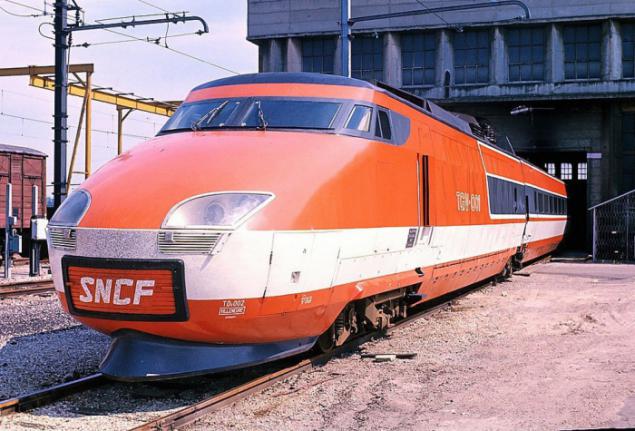
By highways are special requirements in addition to continuous welded rail connections. The radius of the corners is not less than 4000 m. Center distance of adjacent paths at least 4, 5 m, which reduces the aerodynamic effect at the junction of two opposing trains, the relative speed can reach 700 km / h. Tunnels through which the track, specially designed to minimize aerodynamic shock at the entrance and exit of a tunnel. Uses special signaling system on the dashboard and driver provides automatic braking in the event of insufficient fast response driver. Ways securely fenced to prevent collisions with animals. To the pantograph is not able to catch up with the running of a wave on the contact wire, the wire has a higher tension than conventional lines. On the TGV lines there is a limit on the speed, but not from above but from below. This is required in order to slug did not reduce the bandwidth of high-speed lines.
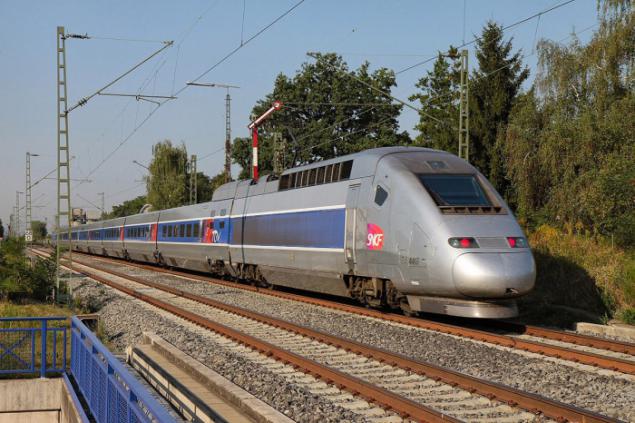
US
Ironically, in the US there is a really high-speed lines. Despite the fact that the trains from Washington-Baltimore-Philadelphia-New York-Boston, manufactured by the French company Alstom. The maximum speed of trains in regular passenger traffic is 241 km / h. Through speed below when traveling from end to end across the 735 kilometer route it is 110 km / h. That is because the French high-speed trains have "dragged" along the old track.
However, in 2013 started the construction of the classical high-speed line between Los Angeles and San Francisco. In 2020 it is planned to put into operation, and the TGV POS will show her all that they are capable of.
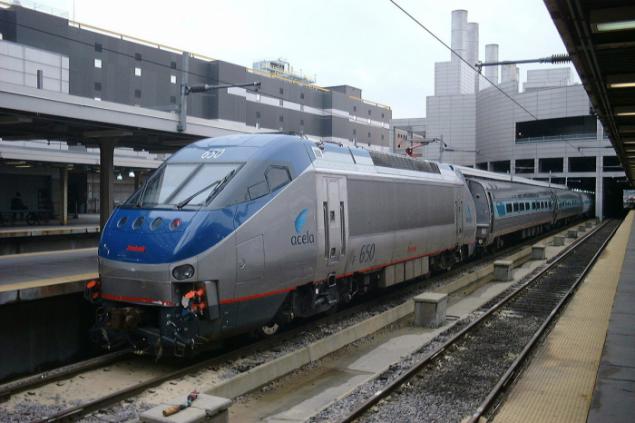
Germany
Intercity-Express - a network of high-speed trains, mainly distributed in Germany, developed by Deutsche Bahn. The current generation of trains Intercity-Express, ICE 3, developed by a consortium of companies Siemens AG and Bombardier under the general direction Siemens AG. Maximum speed ICE trains on a specially built for them portions of the railway network is 320 km / h. On standard sections of the network speed ICE averages 160 km / h. The length of the plots on which ICE can reach speeds of more than 230 km / h, is 1200 km.
ICE is the main type of trains on long-haul destinations, provided by the German railways (Deutsche Bahn). They provide both maximum speed and comfort in movement. ICE became the basis for the development of Siemens AG concern its family of high-speed trains under the common trademark of Siemens Velaro. Projects Velaro realized particularly in Spain and China. These trains are also available in Russian for use on high-speed lines of the Moscow - St. Petersburg and Moscow - Nizhny Novgorod.
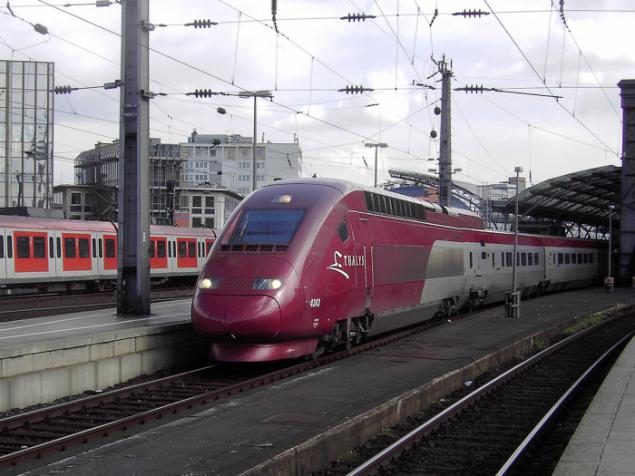
Russia
Route from Moscow to St. Petersburg, which is moved by train "Peregrine Falcon", it should be recognized conventionally speed because for the most part it is a slightly modernized Soviet legacy track facilities. In connection with that produced by the German company Siemens train capable of speeds up to 350 km / h, only one plot stretches 250 km / h. The average speed - 140 km / h.
By 2017, planned to make the track completely expressway. And then move between the two capitals will be reduced from 4 hours to 2.
However, Railways still installed on this line record. The amount of the contract for the purchase and operation of 8 trains exceeded 600 million. Euro. Purchase the same number of fourth-generation fighters would cost cheaper. Pretty expensive, allowing "Petersburg" on the weekend to visit the native land.
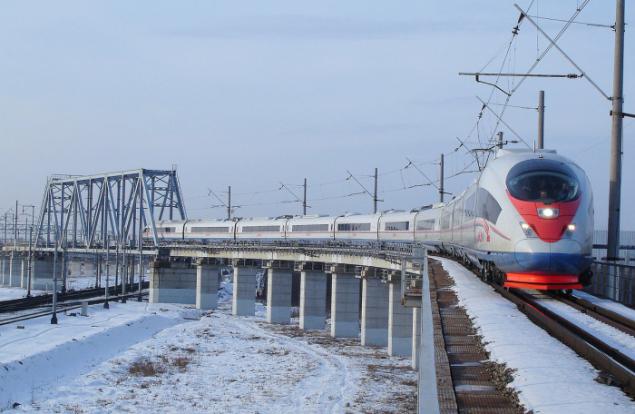
China
China has the largest network in the world of high-speed and high-speed rail, exceed those in Japan and Europe combined. The average speed is 200 km / h or higher.
High-speed and high-speed rail in China include: upgraded conventional rail lines, new lines built specially for high-speed trains, as well as the world's first commercial line for trains on magnetic levitation. As of December 2013 the total length of roads in the PRC amounted to more than 14,400 km, including sections 7268 km in length, with a maximum speed of trains to 350 km / h.
At present, China's booming high-speed rail construction. With the support of the state and because of the special incentive measures is expected that by the end of the 12th Five-Year Plan in 2015, the total length of high-speed rail network will reach 18,000 km.
In technological terms the organization of a high-speed rail link is due to technology transfer agreements from reputable foreign manufacturers such as Bombardier, Alstom and Kawasaki. Adopting foreign technology, China strives to make based on their own development. An example is the development of a series of train CRH-380A, which set a record for high-speed rail in China, about 500 km / h, produced in China and reach speeds of over 350 km / h and from 2010 in the stage of exploitation. It also reported that the new train Beijing - Shanghai will be developed by the Chinese company Shagun Rail Viklz and launched before 2012
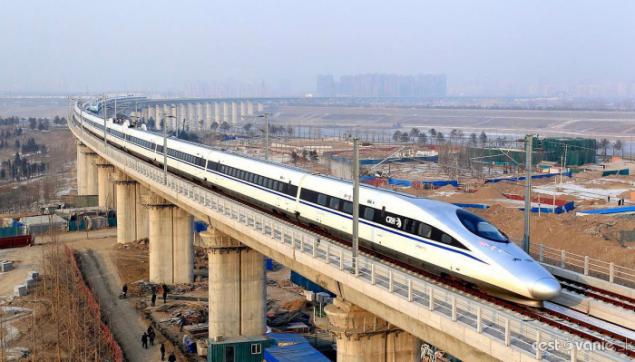
East maglev
Maglev train (maglev) can be carried to rail transport, though they are floating on the canvas at a distance of 1, 5 cm. In this class expresses a speed record of 581 km / h. It is set in 2003 MLX01 Maglev Railway Technical Research Institute of Japan at the test site. It is still not known about the timing of the introduction of the Japanese maglev in commercial operation. However trains fly already stable and dependable, and they rolled over the holidays already residents of the surrounding towns and villages.

Since 2002, China operates 30-kilometer high-speed line connecting Shanghai Airport Padun. This road is used monorail over which after dispersal train hovers at 1, 5 cm. The speed of the Shanghai maglev, built by the German company Transrapid («daughter» Siemens AG and ThyssenKrupp), is 450 km / h.
In the foreseeable future, the Shanghai line will be extended to the city of Hangzhou, and its length is 175 km.
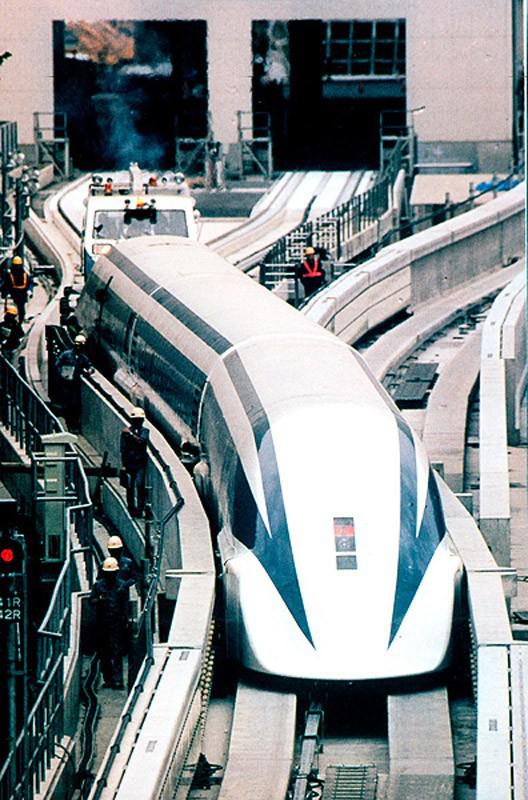
©
The first solution to modernize its railways engaged in Japanese. It happened in the late 50s of last century. This was a necessary event in the run-up to the Tokyo Olympics in 1964. Because Japanese roads were archaic. Track width was only 1,067 mm, the paths were worn out, obsolete fleet of locomotives.
In record time, 5, 5 years, the Japanese built the broad-552-kilometer line "Shinkansen" connected Tokyo and Osaka. Here for the first time in the world of technology have been used jointless laying rails: they are soldered to the kilometer whip and in this form are delivered to the platform to the place of installation. The geometry of the junction of these lashes is that temperature changes do not lead to the formation of gaps between them.

Naturally, there are no crossings on the line, which had to be built over hundreds of bridges and tunnels. On "Sinkansene" was used a fundamentally new type train that with the light hand of journalists was nicknamed "bullet-train". In the bullet train locomotive is missing: the engine is mounted on each axle, which can significantly increase the power.
In 1964, trains ran between Tokyo and Osaka with the speed of 210 km / h. Now train "Nozomi» N-700 flies 552 miles in 2 hours, 25 minutes, accelerating to 300 km / h. At the moment the "Shinkansen", linked together all the major cities of Japan - the most popular form of transport. In 50 years of operation of the train "Shinkansen" walking in the morning and evening with an interval of six minutes, transported nearly 7 billion passengers.

France
Europe responded to the Japanese railway breakthrough with a significant delay. This is partly explained by the fact that European designers in the 1950s-60s enthusiastically experimented with train hovercraft and maglev - the so-called maglev train.
The decision to create a high-speed line, similar to the Japanese, was made in France in the second half of the 1960s. National Railway Company of France took fifteen years to develop and launch the line Paris-Lyon, who was named the TGV (train a` grande vitesse - high speed train). Create route was though costly, but special problems the engineers did not cause. It was more difficult to construct the train itself. And here in the plans of designers unexpectedly intervened global economic conditions. The fact that the first stage was to be used as a locomotive engine gas turbine installation. In 1971 turbopoezd TGV-001 was successfully tested, showing excellent performance. It has a top speed 318 km / h, which is still the world record for trains without electric traction. As it happened in 1973, the energy crisis has forced the leadership to abandon the use of SNCF TGV rose sharply in the fuel. Has shifted to the use of less expensive electricity generated at the French nuclear power plants.

In the end, to the 80-th year and was ready to line Paris-Lyon. The locomotive and wagons manufactured by Alstom. September 27, 1981 the line was put into operation. The distance between the two French cities overcame train 2 hours, moving at a speed of 260 km / h. Now speed lines TGV, covered Europe, reaches 350 km / h. As for the average speed, it is 263, 3 km / h. If this ever happens modernization of rolling stock, creating new models. April 3, 2007 a new type of structure shortened TGV POS has a top speed 574, 8 km / h on the new line LGV EST length of 106 km, connecting Paris with Lorraine. This is an absolute record for the track rail. In this case the braking distance was 32 km.
Trains type TGV POS, cruising through France, Germany, Switzerland and Luxembourg, remind Russian trains. They have two head railcars, which are located between the eight intermediate trailer. Number of seats - 377.

By highways are special requirements in addition to continuous welded rail connections. The radius of the corners is not less than 4000 m. Center distance of adjacent paths at least 4, 5 m, which reduces the aerodynamic effect at the junction of two opposing trains, the relative speed can reach 700 km / h. Tunnels through which the track, specially designed to minimize aerodynamic shock at the entrance and exit of a tunnel. Uses special signaling system on the dashboard and driver provides automatic braking in the event of insufficient fast response driver. Ways securely fenced to prevent collisions with animals. To the pantograph is not able to catch up with the running of a wave on the contact wire, the wire has a higher tension than conventional lines. On the TGV lines there is a limit on the speed, but not from above but from below. This is required in order to slug did not reduce the bandwidth of high-speed lines.

US
Ironically, in the US there is a really high-speed lines. Despite the fact that the trains from Washington-Baltimore-Philadelphia-New York-Boston, manufactured by the French company Alstom. The maximum speed of trains in regular passenger traffic is 241 km / h. Through speed below when traveling from end to end across the 735 kilometer route it is 110 km / h. That is because the French high-speed trains have "dragged" along the old track.
However, in 2013 started the construction of the classical high-speed line between Los Angeles and San Francisco. In 2020 it is planned to put into operation, and the TGV POS will show her all that they are capable of.

Germany
Intercity-Express - a network of high-speed trains, mainly distributed in Germany, developed by Deutsche Bahn. The current generation of trains Intercity-Express, ICE 3, developed by a consortium of companies Siemens AG and Bombardier under the general direction Siemens AG. Maximum speed ICE trains on a specially built for them portions of the railway network is 320 km / h. On standard sections of the network speed ICE averages 160 km / h. The length of the plots on which ICE can reach speeds of more than 230 km / h, is 1200 km.
ICE is the main type of trains on long-haul destinations, provided by the German railways (Deutsche Bahn). They provide both maximum speed and comfort in movement. ICE became the basis for the development of Siemens AG concern its family of high-speed trains under the common trademark of Siemens Velaro. Projects Velaro realized particularly in Spain and China. These trains are also available in Russian for use on high-speed lines of the Moscow - St. Petersburg and Moscow - Nizhny Novgorod.

Russia
Route from Moscow to St. Petersburg, which is moved by train "Peregrine Falcon", it should be recognized conventionally speed because for the most part it is a slightly modernized Soviet legacy track facilities. In connection with that produced by the German company Siemens train capable of speeds up to 350 km / h, only one plot stretches 250 km / h. The average speed - 140 km / h.
By 2017, planned to make the track completely expressway. And then move between the two capitals will be reduced from 4 hours to 2.
However, Railways still installed on this line record. The amount of the contract for the purchase and operation of 8 trains exceeded 600 million. Euro. Purchase the same number of fourth-generation fighters would cost cheaper. Pretty expensive, allowing "Petersburg" on the weekend to visit the native land.

China
China has the largest network in the world of high-speed and high-speed rail, exceed those in Japan and Europe combined. The average speed is 200 km / h or higher.
High-speed and high-speed rail in China include: upgraded conventional rail lines, new lines built specially for high-speed trains, as well as the world's first commercial line for trains on magnetic levitation. As of December 2013 the total length of roads in the PRC amounted to more than 14,400 km, including sections 7268 km in length, with a maximum speed of trains to 350 km / h.
At present, China's booming high-speed rail construction. With the support of the state and because of the special incentive measures is expected that by the end of the 12th Five-Year Plan in 2015, the total length of high-speed rail network will reach 18,000 km.
In technological terms the organization of a high-speed rail link is due to technology transfer agreements from reputable foreign manufacturers such as Bombardier, Alstom and Kawasaki. Adopting foreign technology, China strives to make based on their own development. An example is the development of a series of train CRH-380A, which set a record for high-speed rail in China, about 500 km / h, produced in China and reach speeds of over 350 km / h and from 2010 in the stage of exploitation. It also reported that the new train Beijing - Shanghai will be developed by the Chinese company Shagun Rail Viklz and launched before 2012

East maglev
Maglev train (maglev) can be carried to rail transport, though they are floating on the canvas at a distance of 1, 5 cm. In this class expresses a speed record of 581 km / h. It is set in 2003 MLX01 Maglev Railway Technical Research Institute of Japan at the test site. It is still not known about the timing of the introduction of the Japanese maglev in commercial operation. However trains fly already stable and dependable, and they rolled over the holidays already residents of the surrounding towns and villages.

Since 2002, China operates 30-kilometer high-speed line connecting Shanghai Airport Padun. This road is used monorail over which after dispersal train hovers at 1, 5 cm. The speed of the Shanghai maglev, built by the German company Transrapid («daughter» Siemens AG and ThyssenKrupp), is 450 km / h.
In the foreseeable future, the Shanghai line will be extended to the city of Hangzhou, and its length is 175 km.

©


